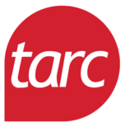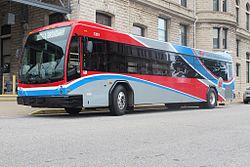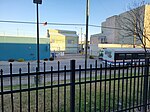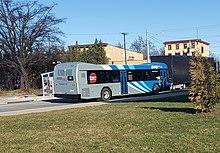Transit Authority of River City
 | |
 TARC 2013 Gillig BRT | |
| Founded | 1974 |
|---|---|
| Headquarters | 1000 W. Broadway Louisville, Kentucky 40203 |
| Locale | Louisville, Kentucky, U.S. |
| Service area | Louisville Metro and southern Indiana |
| Service type | Bus service |
| Routes | 30 (includes four express and one BRT line) |
| Stops | 7,000+ |
| Hubs | 1 |
| Fleet | 227 |
| Daily ridership | 25,100 (weekdays, Q3 2024)[1] |
| Annual ridership | 6,655,200 (2023)[2] |
| Fuel type | ULSD and electricity |
| Chief executive | Carrie Butler (9/20/2020-12/31/2023) Pro-Tem Ozzy Gibson as of (01/01/2024) |
| Website | www |
The Transit Authority of River City (TARC) is the major public transportation provider for Louisville, Kentucky and parts of southern Indiana, including the suburbs of Clark County and Floyd County. TARC is publicly funded and absorbed private mass-transit companies in Louisville, the largest of which was the Louisville Transit Company. In 2023, the system had a ridership of 6,655,200 (about 25,100 per weekday as of the third quarter of 2024).
TARC began bus operations, its only service, in 1974. In 2023, it operated a fleet of 227 accessible buses which run year-round. TARC has a number of specialized routes, providing transportation to major local employers, educational institutions, and recreational events.
History
[edit]TARC was created in 1971 after 1970 legislation authorized city and county governments to operate mass-transit systems with local funding. At the time, public transit was provided in Louisville by the private Louisville Transit Company. The company had long operated mass-transit lines in the city, converting from electric trolleys to diesel buses in the late 1940s and changing its name from the Louisville Railway to the Louisville Transit Company in 1947.[3]
Ridership (includes Louisville Transit Company before 1974):
- 1920: 84 million
- 1970: 14 million
- 1980: 20 million
- 1997: 15 million
- 2006: 15.8 million
- 2017: 14.3 million
- 2021: 4.98 million
Following a trend in cities across the United States, the company saw annual ridership decline from 84 million in 1920 to 14 million in 1970. Its ridership was no longer large enough to cover operating expenses, and in 1971 it posted its first loss. In 1972, the company announced that it would cease operations on September 1, 1974.[3]
The local government began subsidizing fares in July 1973, but this was not enough to make the Louisville Transit Company profitable. Bridge Transit Company (which provided mass transit between Louisville and Jeffersonville) ceased operations at around the same time due to lack of revenue, setting the stage for a metropolitan area without any private mass-transit companies.[3]
Voters approved a controversial 1974 referendum, supported by Mayor Harvey Sloane, which approved an increased occupational tax to fund mass transit.[4] Combined with a federal grant, this was enough for TARC to purchase the Louisville Transit Company, buy new buses, reduce fares, and create new service lines.[3] TARC bought up the area's remaining mass-transit companies: Blue Motor Coach Lines (which served outlying areas) in 1976, and the Daisy Line (connecting New Albany and Louisville) in 1983.[3]
In 1993, TARC experimented with water-taxi service connecting the Belle of Louisville wharf and Towboat Annie's Restaurant in Jeffersonville.[5] During the 1990s and early 2000s, TARC advocated extensive funding to build and operate light rail in the Louisville area; despite wide press coverage, the plans never bore fruit.[citation needed]
In February 1994, an audit committee headed by Bruce Lunsford found that TARC had been mismanaging funds and was depleting its once-large trust fund with increasing expenses such as door-to-door service for the disabled and spending on personal services and fringe benefits for administrators which was higher than that of transit companies in similarly sized cities.[6] TARC's executive director resigned after the audit, and fares nearly doubled before the end of the year.[7] In August 2011, TARC's new $4.5 million, 17,700-square-foot Maintenance and Training Annex received a Gold LEED (Leadership in Energy and Environmental Design) Certification.[8]
TARC began to purchase hybrid buses in 2004, and began purchasing ultra-low-sulfur diesel buses by 2008; by late winter 2012–2013, the company added 16 ULSD buses. Eleven hybrids were added by midsummer 2013, bringing TARC's hybrid total to 32. The company added 21 ULSD buses that fall, and 12 more the following fall; some are equipped with WiFi. Thirteen more updated buses were due to arrive by late 2016, increasing the company's ULSD fleet to 95. Electric buses began operation in downtown Louisville in early 2015 and, according to the Courier Journal, share the 8th Street charging station with a trolley route.[full citation needed] There is another charging station in downtown Louisville, at 3rd and York Streets. The 30-passenger buses can operate for up to two hours on a charge and, like the old trolleys, are fare-free. On November 5, 2019, TARC observed its 45th anniversary; since 2016, the company has added 45 ULSD buses and one hybrid. On January 6, 2020, TARC introduced Kentucky's first bus rapid transit line.[9]
Update: 2021-23 has been big purchasing, and delivery years for TARC. As TARC has purchased, and taken delivery of 72 clean diesel buses, also during FY 2022. TARC purchased 8 more electric buses. With an expected delivery date by the fourth quarter of FY 2024. These 80 buses will replace 80 older buses that have been in service since the mid noughties. TARC now has a clean, and sustainable fleet. That will last well into the 21st century. (See updated bus roster below).
Administration
[edit]
TARC purchased Louisville's Union Station for $2 million in 1977, the year after the former train station had ceased rail operations. The train yard was replaced with a large maintenance facility for TARC buses, and the former train station is now TARC's administrative headquarters.[3] In 2003, TARC significantly remodeled Union Station for the first time since it purchased the facility; the renovation cost $2.1 million.[10]
An eight-member board administers TARC, which had a budget of $67.8 million for the 2008–09 fiscal year.[needs update] Fares cover only about 12 percent of the company's operating expenses; the rest is from Jefferson County's occupational tax, federal aid, and minor sources. [11] The occupational tax, 0.002 percent, covers about two-thirds of TARC's annual operating expenses; the total varies with the availability of federal grants and fares collected.[12] TARC had 710 employees in 2002, 460 of whom were bus drivers.[13]
Some funding is from a TARC transportation trust fund. The fund contained $28 million in 1992, which a local alderman said made TARC the "Cadillac" of America's bus systems. The city unsuccessfully proposed raiding it to fund the Louisville Free Public Library.[14] The fund had declined from $34 million in 1989 to $13 million in 1994, prompting cutbacks and rate hikes that year.[15]
Fleet
[edit]TARC had a fleet of 227 buses in 2020, 32 of which were hybrid buses combining a diesel engine and an electric motor at increased cost. The hybrids were provided through federal highway-bill earmarks by U.S. Senator Jim Bunning. A new TARC diesel bus cost $285,000 in 2007, and a hybrid bus cost $504,000; a new ULSD bus currently costs $405,000, and a hybrid costs $600,000. TARC also operates a fleet of 17 electric buses, reducing diesel emissions by 11,000 pounds (5,000 kg).
TARC announced in October 2010 that its hybrid bus fleet would increase to 21 with nine new buses, due to a grant of $3.9 million from the Federal Transit Authority's Clean Fuels Bus and Bus Facilities Program. A previous grant, through the federal stimulus program, paid for nine hybrid buses which arrived in July of that year.[16]
All buses have "kneeling" technology, which makes them easier to board, and a wheelchair lift. TARC once required disabled riders to use a paratransit service which had to be scheduled in advance, but all regular buses were made accessible after protests in 1986.[17]
| Year | Manufacturer | Model | Fleet # | Fuel type | Image | Notes | ||
|---|---|---|---|---|---|---|---|---|
| 1998 | Gillig | Phantom Advantage Low Floor | 901–999 | Diesel | The retired 901 is being preserved; 922–971 scrapped or sold due to fire damage | |||
| 2000 | Gillig | Phantom Advantage Low Floor 29- and 40-Foot | 2001–2057 | Diesel | Retired | |||
| 2001 | Gillig | Advantage Low Floor 40-Foot | 2101–2111 | Diesel | Retired; 2105 scrapped/sold due to fire damage | |||
| 2002 | Gillig | Advantage Low Floor 29-Foot | 2250–2266 | Diesel | 
|
Retired | ||
| 2003 | Gillig | Advantage Low Floor 40 | 2301–2320 | Diesel | 
|
retired | ||
| 2004 | Gillig | Advantage Low Floor | 2401–2405 | Hybrid | retired | |||
| 2005 | Gillig | Advantage Low Floor 40-Foot | 2501–2516 | Diesel | 3 retired, 2 still.in use the rest stored out of service | |||
| 2007 | Gillig | Advantage Low Floor 40-Foot Hybrid | 2701–2704 | Hybrid | all are stored out of service | |||
| 2007 | Gillig | Advantage Low Floor 35 | 2721–2726 | Diesel | 
|
2726 is retired. 1 still in use the rest stored out of service | ||
| 2008 | Gillig | Advantage Low Floor | 2801–2806 | Diesel | 2801 is stored out of service, 2802 is retired 2803, 2804 are still in use 2805 is stored out of service 2806 is retired | |||
| 2009 | Gillig | Advantage Low Floor 40-Foot Hybrid | 2901–2903 | Hybrid | all are stored out of service | |||
| 2009 | Gillig | Advantage Low Floor 40 | 2910–2926 | some stored out of service | 
|
|||
| 2009 | Gillig | Advantage Low Floor 30 | 2930–2932 | Diesel | 
|
all are stored out of service | ||
| 2010 | Gillig | Advantage Low Floor | 1001–1009 | Hybrid | 
|
one stored out of service | ||
| 2013 | Gillig | Advantage Low Floor | 1301–1316 | Diesel | 
|
|||
| 2013 | Gillig | Advantage Low Floor | 1320–1330 | Hybrid | 
|
|||
| 2013 | Gillig | BRT | 1350–1370 | Diesel | 1370 used on the Dixie Rapid Line | |||
| 2014[18] | Gillig | Advantage Low Floor | 1401–1412 | Diesel | 
|
|||
| 2014[19] | Proterra | Electric | 01-010 stored out of service, 011-017 repurposed for use on rt #52 medical center circulator | 01-017 Proterra BE-30 and Catalist arrived between winter 2015 and summer 2016 | ||||
| 2016 | Gillig | Advantage Low Floor 40-Foot | 1601–1612 | Diesel | 
|
1601–1612 Arrived summer 2016
1613–1625, 1630 arrived February 2017 | ||
| 2017 | Gillig | Advantage Low Floor 40-Foot | 1601–1625, 1630 | Diesel | 1601–1612 Arrived summer 2016; 1613–1625, 1630 arrived February 2017 | |||
| 2018 | Gillig | Advantage 35 Low Floor | 1701–1702 | |||||
| 2019 | Gillig | Advantage 40 Low Floor | 1901–1910 | Diesel | 
|
|||
| 2019 | Gillig | BRT 40 Low Floor | 1921–1928 | Diesel | 1701–1702, 1901–1910, 1921–1928 arrived fall 2018-spring 2019 | |||
| 2021 | Gillig | Advantage Low Floor 40 | 2131–2144 | Diesel | 
|
First trips July 1 | ||
| 2021 | Gillig | BRT Low Floor 40 | 2121–2122 | First trips July 21 | ||||
| 2021 | Gillig | Advantage Low Floor 40 | 2130 | Diesel | First trip in October | |||
| 2021 | Gillig | Advantage Low Floor 40 | 2145–2158 | Diesel | First trip in October | |||
| 2021 | Gillig | Advantage Low Floor 40 | 2159–2170 | Diesel | ||||
| 2021 | Gillig | Advantage Low Floor 35" | 2180–2183 | Diesel | 
|
|||
| 2023 | Gillig | Advantage Low Floor | 2201–2214 | Diesel | 
|
14 ordered with leftover funding, delivered late winter 2022 – early spring 2023 | ||
| 2024 | Gillig | Advantage Low Floor 40" | Diesel | 2321-2331 |  |
All buses are now in service as of
January 2024. |
All buses from Model Year's 2018-2024 have the Allison
B3400XFe transmission |
Delivery fall of 2023.These buses were purchased using leftover funding from FY 2022.
2321 spotted at Light up Louisville 2023. |
| 2024 | Gillig | Advantage Plus Low Floor 40" | 0xx | Electric | 1 | 8 on order | ||
| 2024 | Nova Bus | LFSe 40" | 0xx | Electric | Order cancelled |
Services
[edit]
TARC operates buses which serve the Louisville area. The company claims over 7,000 bus stops, although only about 200 have benches and rain shelters; the rest simply have a sign indicating that the location is a bus stop.[20] The stops are served by 29 weekday and weekend routes, and four express routes with weekday service only. The daily routes are named for the primary road on which they run. There is no more than hour between scheduled buses at any stop on the daily routes, and on weekdays the busiest routes have shorter waiting times. Most of the daily routes have existed under the same name and number for decades, although their routes have almost all been extended to the suburbs.[21]
TARC operates circulators to hospitals, Downtown Louisville and art galleries. Since 1999, it has operated a shuttle service for the University of Louisville's main campus. The company operates two routes shuttling workers to Worldport, the hub of United Parcel Service and one of Louisville's largest employers.[22] TARC launched a "Ride to Safety" program in 2007, which allows domestic abuse victims to use its buses for transportation to a shelter.[23]
It has diesel-powered rubber-tired buses designed like early-20th-century streetcars in the downtown hotel and shopping districts and for shuttle service in other shopping and entertainment areas. The tourist trolleys began operation in November 1987, and their role and fare have varied according to funding.[24]
TARC and its predecessor had provided shuttle access to the Kentucky Derby and Kentucky Oaks since the 1950s, but in 2008 new federal rules required Churchill Downs to negotiate with private companies for service. The shuttle operation transported tens of thousands of people each year and provided TARC with over $200,000 of annual revenue.[25] TARC provides service to other local events, including Thunder Over Louisville and the Kentucky State Fair.[26]
It began a "Bikes on Board" program in 2001, and two-to-three-bicycle bike racks had been installed on all its full-size buses by 2004. In 2005, TARC reported that an average of 6,000 riders a month used the bike racks.[27]
Beginning April 1, 2024, TARC is operating a six-month pilot program known as TARC On-Demand. The first On-Demand zone will be New Albany, Indiana. The second zone will be Jeffersontown, Kentucky. The Jeffersontown zone also launched in Spring 2024. For the cost of $5.00 riders may travel anywhere in the On-Demand Zone. For $2.00 riders may go to the nearest bus stop.[citation needed]
Fares
[edit]The standard fare became $1 in 1994, up from $0.85 during peak hours and $0.50 during off-peak hours. On July 1, 2007, the fare was raised to $1.25. In June 2008, the adult fare was raised to $1.50 to help defray the increased cost of fuel. Since July 1, 2012, the adult fare has been $1.75.[28] In 2018, fare boxes began to be updated. Smart cards would be accepted at a discount fare of $1.50, and riders paying cash would have to have exact change.[29] Discounts are offered to senior citizens and high school students.[28] A "day tripper" one-day pass can be purchased for $3.50 while boarding the bus.[28][29] Express fares are $2.75, or $1 with a bus pass.[28] Up to three children under age six accompanied by a fare-paying rider ride for free.
TARC began an automated fare-collection system with new magnetic fare cards on January 7, 2019, and launched a new app.[30] The full one-way cash fare was $1.75 ($1.50 with a MYTARC fare card). A MYTARC 24-hour card was $3.50, $15 per week, or $50 for 30 days. A smart-card youth summer pass became available in late May 2019. The fare for seniors and persons with disabilities was $0.80 cents (cash or smart card), and 10-trip cards were available for $8.[31] Mobile Ticketing first became available July 1, 2019 through a pilot program. Only one route, the #4 Fourth St. route, used Mobile-Ticketing. The pilot program lasted 13 days. Fast forward nearly 5 years later, and Mobile-Ticketing is making a comeback, beginning April 23, 2024. Fares will remain unchanged.[32]
Bus rapid transit
[edit]
TARC introduced Kentucky's first bus rapid transit route on January 6, 2020, branded as Dixie Rapid. It has 37 distinctly-signed stops, and 11 silver-and-blue buses. Service was every 15–30 minutes, 20 hours a day, seven days per week. Twenty-minute service ran from 4:00 to 5:30 am and 7:00 pm to midnight, with 15-minute service from 5:30 am to 7:00 pm Monday to Friday. Saturday and Sunday had 30-minute service from 4:30 to 7:00 am and 7:00 pm to midnight, and 20-minute service from 7:00 am to 7:00 pm. The route was created as part of the nearly-three-year, $35 million New Dixie Highway project.[33][34]
See also
[edit]- List of bus transit systems in the United States
- Transportation in Louisville, Kentucky
- List of roads in Louisville, Kentucky
References
[edit]- ^ "Transit Ridership Report Third Quarter 2024" (PDF). American Public Transportation Association. November 20, 2024. Retrieved November 23, 2024.
- ^ "Transit Ridership Report Fourth Quarter 2023" (PDF). American Public Transportation Association. March 4, 2024. Retrieved September 5, 2024.
- ^ a b c d e f Kleber, John E., ed. (2002). The Encyclopedia of Louisville. University Press of Kentucky. p. 892.
- ^ Ryan, Ed (November 6, 1974). "Transit referendum". The Courier-Journal.
- ^ Staff writer (May 6, 1993). "Maiden voyages of TARC water taxi draw 4,500". pp. 3B.
- ^ Walfoort, Nina (February 5, 1994). "TARC audit assails budget, management". The Courier-Journal. pp. 1A.
- ^ Walfoort, Nina (February 11, 1994). "Arnett resigns: TARC's financial priorities redirected". The Courier-Journal. pp. 1B.
- ^ TARC's Maintenance and Training Annex receives Gold Certification Archived April 25, 2012, at the Wayback Machine
- ^ "New Dixie Highway Bus Rapid Transit Line".
- ^ Shafer, Sheldon (September 6, 2003). "Time-worn Union Station gets a face-lift". The Courier-Journal. pp. 1B.
- ^ Shafer, Sheldon (June 3, 2008). "Rising fuel bill may push TARC fares up 25 cents". The Courier-Journal. Archived from the original on November 3, 2012.
- ^ Shafer, Sheldon (August 4, 2008). "TARC jumps on fuel deal". The Courier-Journal. p. 1B.
- ^ Green, Marcus (November 14, 2002). "TARC will get award for workplace fitness". pp. 1F.
- ^ O'Doherty, Mary (June 23, 1992). "Bather would raid TARC to aid library". The Courier-Journal. pp. 1A.
- ^ Walfoort, Nina. "TARC begins push for another round of fare increases". The Courier-Journal. pp. 1B.
- ^ "Hybrid Bus fleet grows to 29". Bizjournals.com. October 28, 2010. Retrieved January 27, 2011.
- ^ Jessie, Lisa (July 23, 1988). "7 disabled people held after protest of bus line". The Courier-Journal. pp. 7A.
- ^ LAMMERS, BRADEN. "TARC unveils high-tech bus fleet, $30M upgrade plan". News and Tribune. Retrieved December 11, 2021.
- ^ "TARC Announces fleet of electric buses to celebrate 40th anniversary". WDRB. Retrieved December 11, 2021.
- ^ Shafer, Sheldon (January 1, 2006). "TARC seeks state funds to build shelters". The Courier-Journal. pp. 1B.
- ^ Shafer, Sheldon (August 21, 2008). "Gas prices get people on board with TARC". The Courier-Journal. p. 1A.
- ^ "TARC – Route listing". Transit Authority of River City. Archived from the original on June 12, 2008. Retrieved June 6, 2008.
- ^ Gerth, Joseph (December 27, 2006). "Buses will help take abuse victims to safety". The Courier-Journal. pp. 1B.
- ^ Shafer, Sheldon (August 9, 1988). "Free trolley rides expected through '88". The Courier-Journal. pp. 2B.
- ^ Shafer, Sheldon (March 27, 2008). "Rule change gives others shot at Derby bus runs". The Courier-Journal. pp. 1A.
- ^ Halladay, Jessie (April 9, 2008). "Surviving Thunder's roads". The Courier-Journal. pp. 1B.
- ^ Bruggers, James (January 18, 2005). "More bikers hitching a ride on TARC". The Courier-Journal. pp. 1A.
- ^ a b c d "Fares and Online Purchasing". TARC. Retrieved October 4, 2014.
- ^ a b "New Fare Collection System". TARC. Archived from the original on November 3, 2013. Retrieved October 4, 2014.
- ^ "Home". TARC.
- ^ "efare". mytarc.ridetarc.org.
- ^ "New Bus routes and mobile ticketing". Ridetsrc. December 20, 2019.
- ^ "The New Dixie Highway". The New Dixie Highway. December 13, 2017.
- ^ Kobin, Billy (January 3, 2020). "Bus Rapid Transit". Courier Journal. Retrieved January 11, 2020.
- Top TARC official to resign at the end of 2023
- Longtime Louisville city employee Ozzy Gibson named interim director of TARC
- TARC testing mobile ticketing, offering free rides on select Route 4 buses starting July 1
- MyTARC Mobile
External links
[edit]- TARC officials pondering broad look at services, routes
- Official TARC Website
- TARC Awarded $4.4 Million Federal Grant for All-Electric Buses—Louisville.gov September 19, 2012
- TARC Awarded $9 million in federal grants—Business First October 28, 2010
- TARC Bike Rack Rap on YouTube
- 1961 system map
- Tarc annual report [1]

